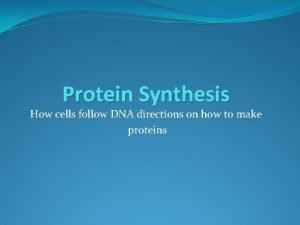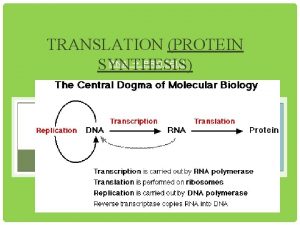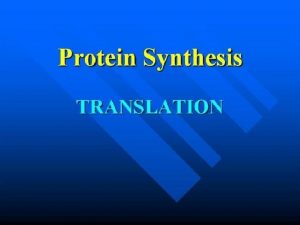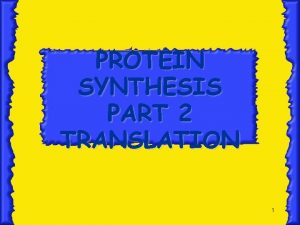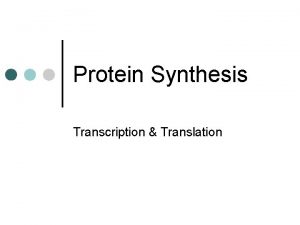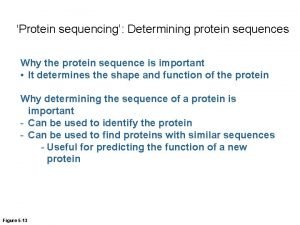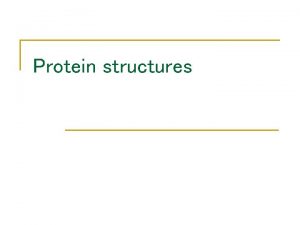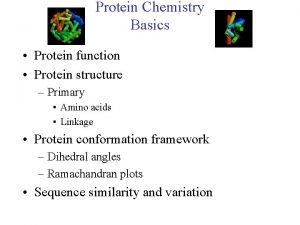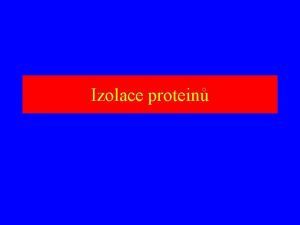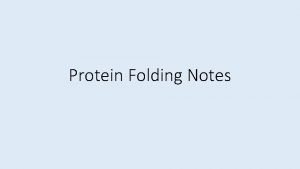Translation Making the Protein Translation Overview l Translation

















- Slides: 17

Translation. Making the Protein

Translation Overview l Translation involves m. RNA→Protein l Materials needed for translation l Ribosome l t. RNA’s with the correct amino acid connected to it. l Mature m. RNA 2

Ribosome Structure l 1. Ribosomes-are made from proteins and r. RNA. It has two subunits, a small subunit and a large subunit. There are three sites where the t. RNA attaches. l The A site is where the t. RNA arrives with the amino acid. l The P site has a t. RNA that attaches to the t. RNA at the A site. l The E site is where the t. RNA exits without an amino acid. 3

Structure of t. RNA 2. t. RNA brings the correct amino acid to the m. RNA. 4

Structure of t. RNA 5

Attaching an Amino Acid to a t. RNA The t. RNA must get its amino acid by combining with a charging enzyme (aminoacyl-t. RNA synthetase). This enzyme will "put" the correct amino acid on to the t. RNA according to its anticodon. ATP is also needed in this process. 6

Initiation of Translation The parts to translation are 1. Initiation 2. Elongation 3. Termination 1. Initiation- The small subunit attaches to the m. RNA at AUG (start). Now the t. RNA with the anticodon UAC will attach to the P site. Then the large subunit will attach to the small subunit. 7

Elongation 2. Elongation- The second t. RNA arrives and attaches at the A site, with the correct anticodon and the correct amino acid. A peptide bond is formed between the amino acids and water is removed. 8

Termination 3. Termination- At the stop codon, a stop protein (release factor) will attach at the A site. This will cause the release of the last t. RNA, the polypeptide chain and cause the ribosome to fall apart. 9

Exported Proteins Exported proteins are tagged and interact with signal recognition particles (SRP). This SRP is responsible for threading the synthesized protein into the lumen of the E. R. 10

Remember amino acids? l l There are 20 (some textbooks say 21 or 22 because there are variants) R represents a side-chain specific to each amino acid.


Protein Structure

Base Pair Mutations and Effects on Proteins There are three types of base pair mutations • No effect on proteins structure • Missense mutation. Change in one amino acid • Nonsense mutation. Shortening of the polypeptide chain 14

Frameshift Mutations the Effect on Proteins Frameshift mutations result from either an insertion or a deletion of a nucleotide. Missense mutation- Change in one amino acid sequence for the rest of the chain. Three insertions or deletions will put the polypeptide chain back on track. Nonsense mutation. Shortening of the polypeptide chain. 15

Protein Syntheis: A Review 16

Homework 1. 2. 3. Explain the role of codons, ribosomes and t. RNA in protein synthesis in eukaryotic cells. Explain how a single base-pair mutant in DNA can alter the structure and function of a protein. Using a real life example discuss the potential consequences of the production of a mutant protein to the structure and function of the cells of an organism. How is translation different in prokaryotes and eukaryotes?
 Carrier vs channel proteins
Carrier vs channel proteins Protein-protein docking
Protein-protein docking Steps in making a protein
Steps in making a protein Overview of transcription and translation
Overview of transcription and translation Translation biology
Translation biology War making and state making as organized crime
War making and state making as organized crime Is making inference simply making a guess
Is making inference simply making a guess Thiếu nhi thế giới liên hoan
Thiếu nhi thế giới liên hoan Khi nào hổ mẹ dạy hổ con săn mồi
Khi nào hổ mẹ dạy hổ con săn mồi Chúa yêu trần thế alleluia
Chúa yêu trần thế alleluia điện thế nghỉ
điện thế nghỉ Một số thể thơ truyền thống
Một số thể thơ truyền thống Trời xanh đây là của chúng ta thể thơ
Trời xanh đây là của chúng ta thể thơ So nguyen to
So nguyen to đặc điểm cơ thể của người tối cổ
đặc điểm cơ thể của người tối cổ Tỉ lệ cơ thể trẻ em
Tỉ lệ cơ thể trẻ em Fecboak
Fecboak Các châu lục và đại dương trên thế giới
Các châu lục và đại dương trên thế giới


